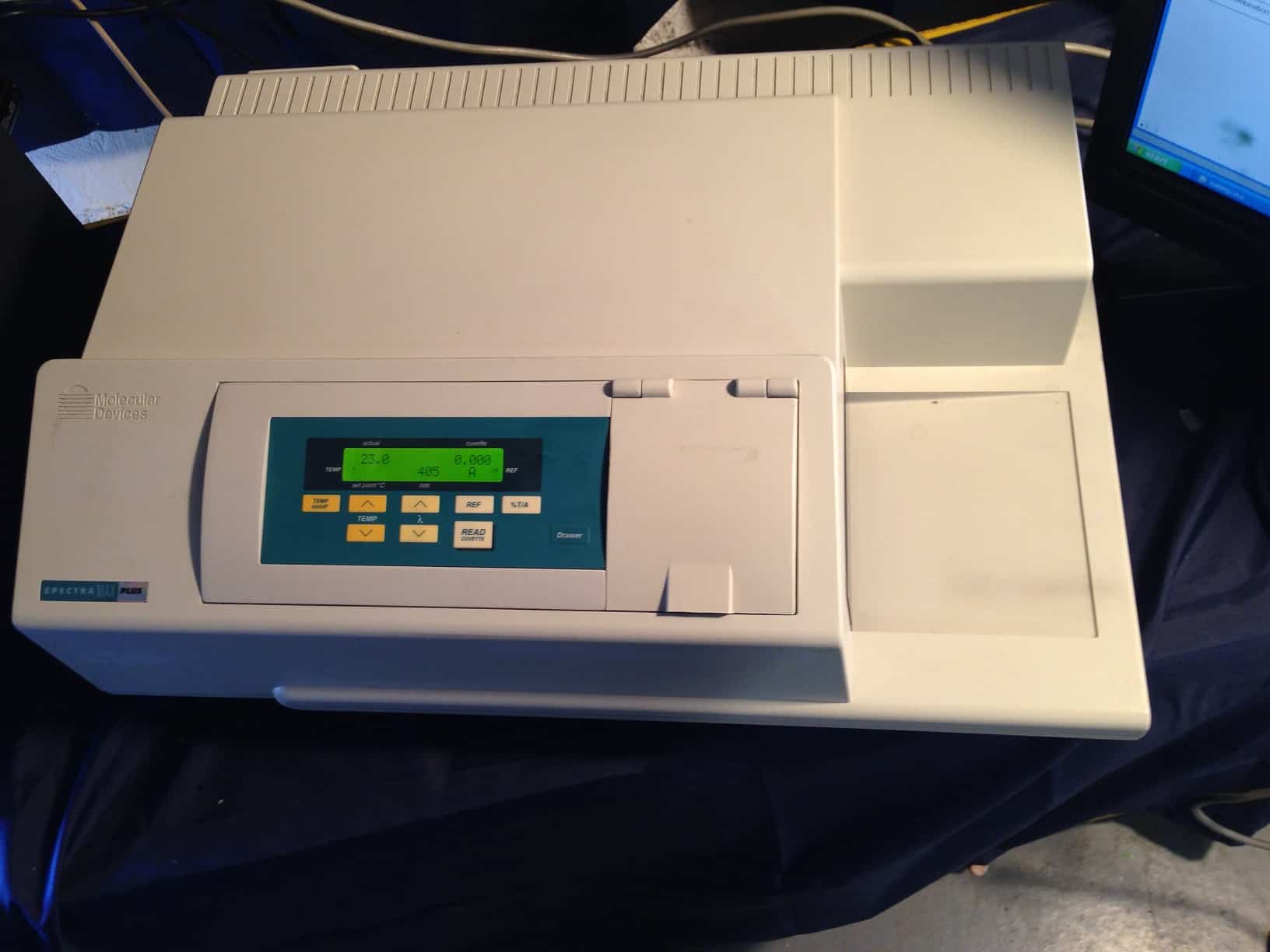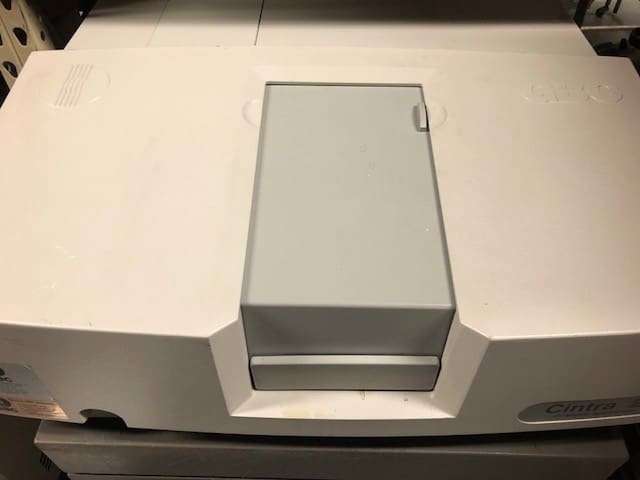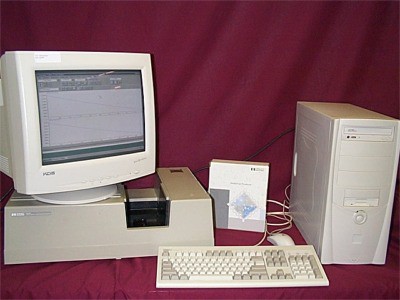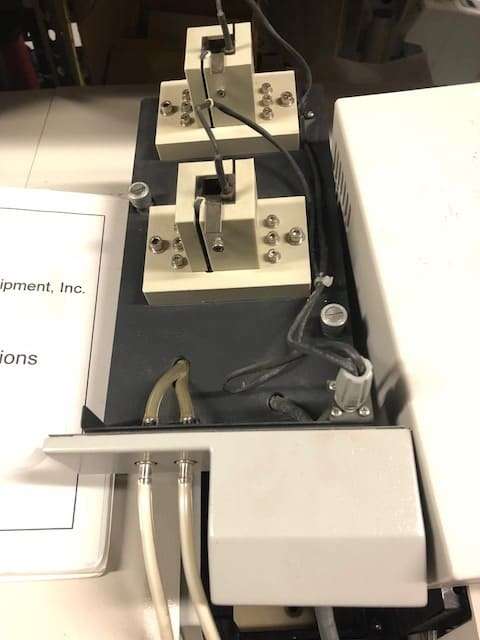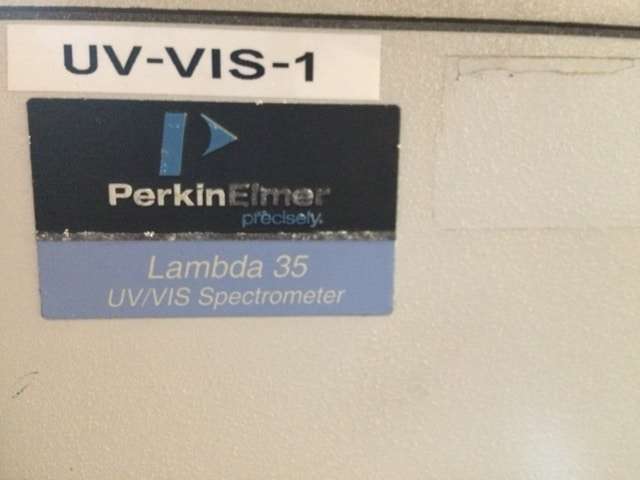- Your cart is empty
- Continue Shopping

Product
Microplate Reader, Molecular Devices Spectramax 384 plus, Refurbished
The SPECTRAmax™ PLUS 384 microplate spectrophotometer provides rapid and sensitive UV/VIS measurements of a variety of analytes including specific proteins, nucleic acids, and other molecules across a wide range of concentrations. It measures the optical density (OD) of samples in both 96- and 384-well microplates or in a cuvette at a selected wavelength for a single point in time (endpoint), over a specified period of time (kinetic), or over a selected wavelength range (spectral scan).
The SPECTRAmax™ PLUS 384 microplate spectrophotometer provides rapid and sensitive UV/VIS measurements of a variety of analytes including specific proteins, nucleic acids, and other molecules across a wide range of concentrations. It measures the optical density (OD) of samples in both 96- and 384-well
microplates or in a cuvette at a selected wavelength for a single point in time (endpoint), over a specified period of time (kinetic), or over a selected wavelength range (spectral scan).
Specifications
Technical specifications are subject to change without notice.
Photometric Performance
Wavelength range 190–1000 nm
Wavelength selection Monochromator tunable in 1-nm increments
Wavelength bandwidth £ 2.0 nm FWHM (full width half maximum)
Wavelength accuracy ± 1.0 nm across wavelength range
Wavelength repeatability ± 0.2 nm across all optical channels
Photometric range -0.3 to 4.000 OD
Photometric resolution 0.001 OD
Photometric accuracy/linearity
(microplate), 0–2.0 OD: 190–1000 nm <± 1.0% and ± 0.006 OD
Photometric accuracy/linearity
(cuvette), 0–2.0 OD: 90–1000 nm <± 1.0% and ± 0.005 OD
Photometric precision
(repeatability), 0–2.0 OD: 190–1000 nm <± 1.0% and ± 0.003 OD
Stray light £ 0.05% at 230 nm
Photometric stabilization Instantaneous
Photometric drift None—continuous referencing of monochromatic output
Calibration Automatic before first kinetic read and before every endpoint
reading
Optical alignment None required
Light source Xenon flash lamp (5 watts)
Average lamp lifetime 1 billion flashes
Illumination Top down (microplates); horizontal (cuvettes)
Photodetectors Silicon photodiode
Instrument Description
Photometric Analysis Modes
Stand-Alone
• Single wavelength Absorbance or %Transmittance reading
of the cuvette (or test tube)
Using SOFTmax PRO
• Express data as Absorbance or %Transmittance
• Single wavelength reading of microplate and/or cuvette
• Multiple wavelength (up to six) reading of microplate and/
or cuvette
• Kinetic and kinetic graphics of microplate and/or cuvette
• Spectral scan (190–1000 nm) of microplate and/or cuvette
Measurement Time (calibration off)
Microplate
Read time (endpoint)
— Standard read • 96 wells in 9 seconds (single wavelength)
• 96 wells in 9*N seconds (N wavelengths)
• 384 wells in 29 seconds (single wavelength)
• 384 wells in 29*N seconds (N wavelengths)
— Speed read • 96 wells in 5 seconds (single wavelength)
• 96 wells in 5*N seconds (N wavelengths)
• 384 wells in 16 seconds (single wavelength)
• 384 wells in 16*N seconds (N wavelengths)
Kinetic read intervals • 96 wells, 9-second minimum interval between readings
(single wavelength)
• 1 column, 2-second minimum interval between readings
(single wavelength)
• 384 wells, 29-second minimum interval between readings
(single wavelength)
Cuvette
Read time (endpoint) • 1 second (single wavelength)
Kinetic read intervals • 2-second minimum interval between readings
(single wavelength)
Scan Speed
Cuvette: Normal scan 45*K nm/min (K = wavelength interval)
Cuvette: Speed scan 130*K nm/min
Microplate: Normal scan 33*K nm/min (8-well strip); 21*K nm/min (16-well strip)
Microplate: Speed scan 135*K nm/min (8-well strip); 77*K nm/min (16-well strip)
The on-board microprocessor calculates and reports the absorbance (or % Transmittance) for each well of a microplate. Data from multiple wavelengths can be acquired during a single reading, if desired, and different calculations can be made based on this data using SOFTmax PRO software, including the subtraction of blanks, use of standard curves, etc. Typical applications include endpoint assays (quantitation of cytoproliferation by MTT reduction, colorimetric protein assays, protein measurement at 280 nm, DNA/RNA measurement at 260 nm, and endpoint ELISAs) and kinetic measurements (enzyme studies, such as determination of the activity of enzymes released from cells, and kinetic ELISAs).
All standard 96- and 384-well microplates, strip wells, and filter-bottom microplates can be used in the SPECTRAmax PLUS 384. When reading at wavelengths below 340 nm, special UV-transparent, disposable or quartz microplates and cuvettes that allow transmission of the far UV spectra must be used.
With SOFTmax PRO, the contents of the wells in a microplate can be mixed automatically by shaking before each read cycle, making it possible to perform kinetic analysis of solid-phase, enzyme-mediated reactions (mixing is not critical for liquid-phase reactions). The temperature of the microplate chamber can also be regulated, if desired, from 4°C above ambient to 45°C.

